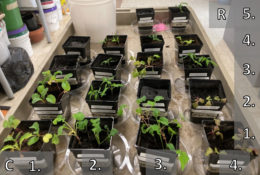Editor’s Note: In these last two weeks of 2022, we’ll be looking at a few selections that we haven’t yet discussed on AAS Nova from among the most-downloaded articles published in AAS journals this year. The usual posting schedule will resume in January.
CI Asteroid Regolith as an In Situ Plant Growth Medium for Space Crop Production
Published July 2022
Main takeaway:
Steven Russell (University of Wisconsin−Madison; University of North Dakota) and collaborators studied the possibility of growing plants in soil derived from the loose surface material, or regolith, of asteroids. While lettuce, radishes, and peppers all grew in mixtures of simulated regolith and peat moss, increasing the amount of regolith decreased the yield of each plant, and no seeds sprouted in pure regolith.
Why it’s interesting:
If humans want to explore the solar system, we’re going to need a way to produce substantial amounts of food in space. One possible plant-growing medium is asteroid regolith, which is abundant in our solar system. Recent studies of meteorites as well as spacecraft missions to asteroids, such as the Hayabusa2 mission to Ryugu and the OSIRIS-REx mission to Bennu, have suggested that certain types of asteroids called carbonaceous asteroids contain nearly unaltered material left over from the formation of our solar system. These primitive asteroids are particularly promising sources of “soil” since they contain small amounts of carbon, minerals, and nutrients.
What we learned from sowing seeds in asteroid dirt:

Experimental results 55 days after planting. The pots with no visible growth contain pure simulated regolith. [Adapted from Russell et al. 2022]
Citation
Steven. J. Russell et al 2022 Planet. Sci. J. 3 155. doi:10.3847/PSJ/ac74c9
